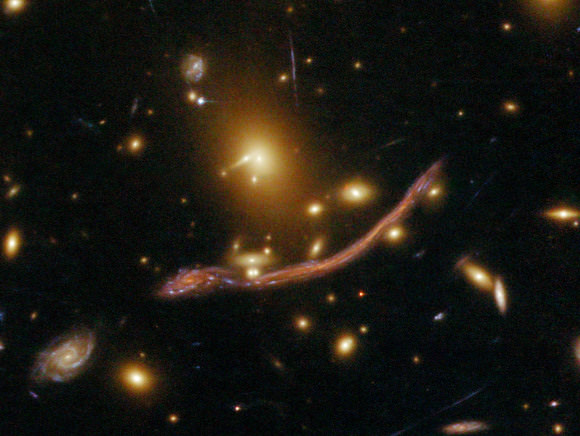We’re on to the next cto, yibai, cien, cento, hundred of Where In The Universe Challenges. You know what to do: take a look at this image and see if you can determine where in the universe this image is from; give yourself extra points if you can name the instrument responsible for the image. We’ll provide the image today, but won’t reveal the answer until tomorrow. This gives you a chance to mull over the image and provide your answer/guess in the comment section. Please, no links or extensive explanations of what you think this is — give everyone the chance to guess.
UPDATE: The answer is now posted below.
In honor of Hubble’s 20th birthday, this is an image from the venerable HST, taken shortly after the final repair mission. This is a portion of an image taken by Hubble in July 2009 of the galaxy cluster Abell 370. This is one of the very first galaxy clusters where astronomers observed the phenomenon of gravitational lensing, where the warping of space by the cluster’s gravitational field distorts the light from galaxies lying far behind it. So, the background galaxies appear stretched, and the image also includes as arcs and streaks. This image was taken by the Advanced Camera for Surveys. You can see a larger version and more info at the HubbleSite.


This is a long, long time ago, in a galaxy far, far away. As shot by Hubble. 😉
Or, in other words, I don’t know what the region of space is, although I can tell you that the massive elliptical galaxy in the middle (& friends, of course) is gravitationally lensing the distorted spiral.
Top right hand corner of the Abell 370 Image taken by the Hubble Advanced Camera for Surveys, Wide Field mode, July 2009.
It´s somewhere in the Hubble Deep field. By Hubble Space Telescope. 🙂
One of my faves….
Lensing galaxy cluster Abell 370 imaged by the Hubble ACS.
I KNOW!
SDSS J1004+4112 Galaxy
actually comet to think of it.. I’m thinking of something else.
but it is gradational lensing taking by hubble of…..i forgot.
wow.
If that’s gravitational lensing then I think that a few of the bright objects seen “touching” the distorted pink galaxy are adding their own lensing on top of it.
The lensing I’ve seen most often are thin streaks or duplicate points of light of the same quasar.
Way cool.
That is a wild gravitational lens. I ahve not yet found it on a Hubble site to verify whether it is Abell 370
LC
The galaxy with the tail is BOW ACO 370 CC009 in cluster ACO 370. Redshift is 92,171 km.s^-1
Image with the HST ACS WFPC3 image using the F475W (g), F625W (r), and F814W (I) filters.
It was first discovered in September 1986 from the Toulouse Observatory using the 3.6 metre telescope using an image by RCA2 CCD.
It just doesn’t look like a gravitational lensing to me. I’ll call it a galactic stream caused by a relatively recent collision or close brush with another galaxy.
Thanks to the colouration used I know that this is a gravitational lensing event caused by one of the clusters listed in Abell’s catalogue, and that the instrument used was the Hubble. The ACS on the Hubble, to be precise.
Gravitational lensing of a spiral galaxy by Galaxy Cluster Abell (ACO) 370. An image taken by HST.
@neoguru,
I agree. But the image looks distorted.
Maybe dust between behaves the same as light in photonic crystals, having an identity crisis.
Showing unexpected transverse propagation of light.
Look for FOM institute, Subwavelength Structure of the Evanescent Field of an Optical BlochWave, Physical Review Letters, vol. 102, 023902 (2009); 16 januari 2009.
You are showing courage btw, impressive,
Some gravitational lensing around some galaxy cluster somewhere,…
I’d say its Hubble with the galaxy cluster Abell 370. A little bit of googling gave me a nice picture on apod 21st september 2009.
As others have noted, Abell 370 by Hubble. It’s part of one of the images released at the first press conference following the last servicing mission, demonstrating how the repaired Advanced Camera for Surveys is doing.